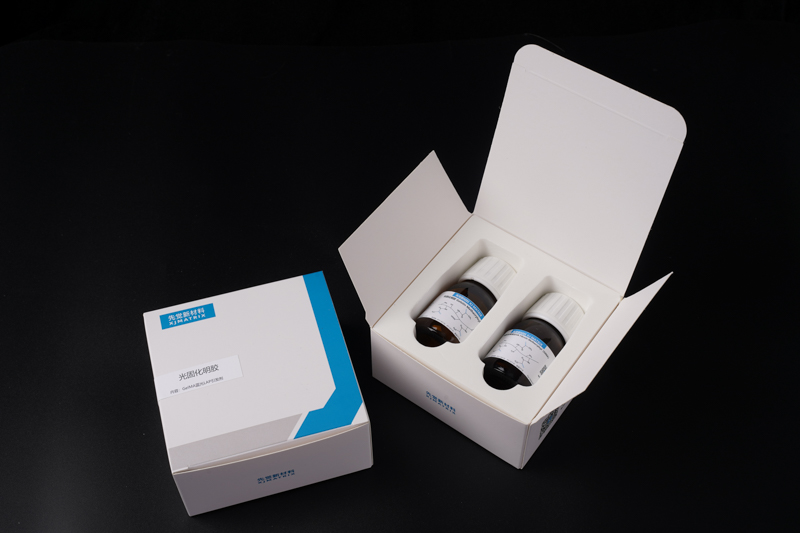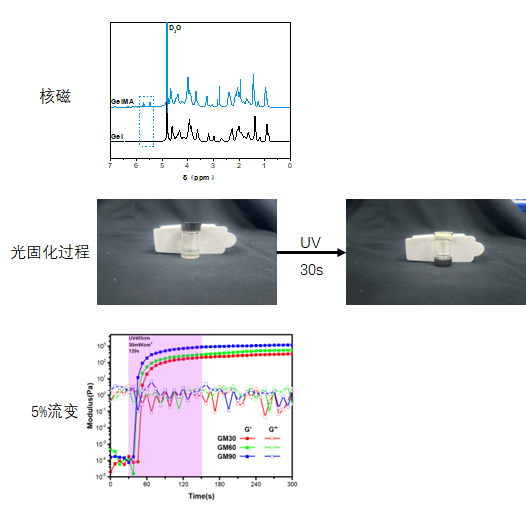| Make UP | Appearances | Specification | Storage Condition |
| GelMA | White lyophilized sponge | 1 g/bottle | Warranty: 12 months at 4℃, 18 months at -20℃. |
| Blue light initiator LAP | White powder | 10 mg/bottle |

Gelatin methacryloyl (GelMA) is a double-bond modified gelatin that can be crosslinked to form hydrogels by ultraviolet and visible light with the addition of photoinitiators.GelMA hydrogels have excellent biocompatibility and adjustable mechanical properties, and are widely used in biomedical fields such as tissue engineering, 3D printing, and drug delivery.
| Make UP | Appearances | Specification | Storage Condition |
| GelMA | White lyophilized sponge | 1 g/bottle | Warranty: 12 months at 4℃, 18 months at -20℃. |
| Blue light initiator LAP | White powder | 10 mg/bottle |
Gelatin methacryloyl (GelMA) is a double-bond modified gelatin that can be crosslinked to form hydrogels by UV and visible light with the addition of photoinitiators.GelMA hydrogels have excellent biocompatibility and adjustable mechanical properties, and are widely used in biomedical fields such as tissue engineering, 3D printing, and drug delivery.
Molecular Structure:

Steps for use:
1. Prepare 0.5mg/mL standard solution of initiator
Add 20mL of solvent (DMSO, sterilized water, PBS, etc.) to the brown glass bottle containing the initiator LAP, and dissolve for 30 min in a 37 ℃ water bath with heat, shaking several times to fully dissolve.
2. Prepare GelMA solution (recommended concentration 5-20%)
Take appropriate amount of GelMA into the centrifuge tube, add the prepared LAP standard solution, 50 ℃ water bath to dissolve for 30 min, repeated shaking, fully dissolved.
Curing into gel:
1. Use 405nm blue light to irradiate the above solution containing initiator, about 30s can be cured into glue (irradiation time is related to the concentration of GelMA and the blue light source, according to the required strength of the glue can be appropriately adjusted curing time);
2. if use 2959 initiator, need to use 365nm UV light for irradiation and extend the irradiation time (LAP is more efficient than 2959 initiator, shorter time), UV light will hurt the skin and eyes attention to protection.
2D cell culture:
1. Dissolve the GelMA solution containing LAP according to the above dissolution protocol and pass it through a 0.22μm filter membrane while it is still hot;
2. Add appropriate amount of GelMA solution into the well plate to cover the bottom surface of the plate;
3. UV light curing for about 30-60s. 4;
4. Wash the cured GelMA with PBS several times, or use culture medium for rinsing;
5. After cell counting, inoculate the cell suspension into the well plate and observe the adherence situation and subsequent cell culture after 24h.
Examples:
1. GelMA for cell 3D culture (day 7)

2. Physical and chemical properties of GelMA with 30%, 60%, 90% substitution

Precautions:
1. It is recommended to increase the irradiation time appropriately to obtain better curing effect. Recommended time: GelMA concentration ≤15%, irradiation time ~ 30s; GelMA concentration >15%, irradiation time ~ 20s;
2. Due to the temperature-sensitive nature of GelMA, its solution is easy to be cured under low temperature. Therefore, please do not repeatedly freeze and thaw when using, so as not to affect the performance of the product. 3;
3. use 2959 initiator need higher temperature to dissolve in water or PBS (solubility in water ≥ 5mg/mL);
4. LAP initiator solution can be stored for 12 months at 4℃ under light protection, but it is recommended to use it now;
5. It is recommended to use LAP initiator for cellular experiments because blue light irradiation is gentler to cells than UV.
6. After adding LAP, the solution needs to be protected from light and the centrifuge tube can be wrapped with tin foil.
See the package for production date:
Suzhou Xianjue New Material Technology Co.
Tel: 18068408145
Address: 2nd Floor, Yue Long Business, No.1360 Jinji Lake Avenue, Suzhou, China
